
Grundlagen der Kriminaltechnik I
- 140 pages
- English
- ePUB (mobile friendly)
- Available on iOS & Android
Grundlagen der Kriminaltechnik I
About this book
Die kriminaltechnischen Untersuchungsmethoden wurden in den letzten Jahren zunehmend verfeinert. Der Sachbeweis hat damit sowohl im Ermittlungsverfahren als auch im Strafprozess in erheblichem Maße an Bedeutung gewonnen. Beweisführung und Urteilsfindung vor Gericht stützen sich mehr und mehr auf den Sachbeweis.In den Lehr- und Studienbriefen Band 16 und 17 stellen die Autoren, ausgehend von einem versuchten Sexualdelikt als Leitsachverhalt, umfassend und praxisnah, den derzeit aktuellen Stand der kriminaltechnischen Möglichkeiten dar. Die wesentlichen Spurenkomplexe werden allgemein verständlich anhand dieses Sachverhaltes erläutert und durch umfangreiches farbiges Bildmaterial veranschaulicht.Der vorliegende Band "Grundlagen der Kriminaltechnik I" handelt die kriminaltechnischen Begriffe, die Grundlagen der Spurensuche und der Spurensicherung ab. Dargestellt wird auch der derzeitige Stand der Fototechnik zur Dokumentation des Tatbefundes. Ausführlich werden in diesem Band die wesentlichen Formspuren erläutert, so u.a. Fingerspuren, Werkzeugspuren und Schuhabdruckspuren.Der Band "Grundlagen der Kriminaltechnik II" widmet sich u.a. DNA-Spuren, Schussspuren, Haarspuren, digitalen Spuren und Brandspuren sowie chemischen Fangmitteln. Zudem findet sich hier eine ausformulierte Lösungsskizze zu den Fragestellungen der kriminalistischen Fallanalyse des Leitsachverhaltes und zu ausgewählten Ermittlungsmaßnahmen
Frequently asked questions
- Essential is ideal for learners and professionals who enjoy exploring a wide range of subjects. Access the Essential Library with 800,000+ trusted titles and best-sellers across business, personal growth, and the humanities. Includes unlimited reading time and Standard Read Aloud voice.
- Complete: Perfect for advanced learners and researchers needing full, unrestricted access. Unlock 1.4M+ books across hundreds of subjects, including academic and specialized titles. The Complete Plan also includes advanced features like Premium Read Aloud and Research Assistant.
Please note we cannot support devices running on iOS 13 and Android 7 or earlier. Learn more about using the app.
Information
Table of contents
- Cover
- Titel
- Impressum
- Vorwort
- Inhalt
- Zur Einführung
- 1 Begriffsbestimmungen
- 2 Spurensuche
- 3 Grundlagen der Spurensicherung
- 4 Einzelspuren
- Fußnoten
- Zu den Autoren
- Quellenverzeichnis
- Abbildungsverzeichnis